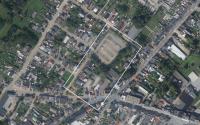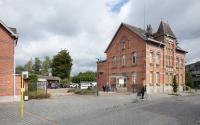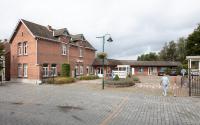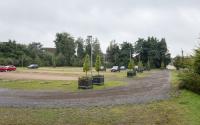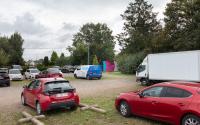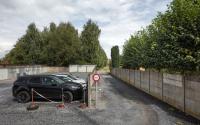Heist-op-den-Berg - Residential care centre

Selection
- AIDarchitecten
- Eagles of Architecture
- osararchitects nv
- Sergison Bates architects Brussels
Project description
The local authorities of Heist-op-den-Berg and the welfare association De Zilveren Zwaan want to create a lively and sustainable welfare campus on the Public Centre for Social Welfare (OCMW) site and the Vlinder parking lot, with maximum connection to the area and the surroundings and a low-threshold meeting place for young and old. The first major realization within the long-term vision for the welfare campus concerns the landscape integration and the construction of a residential care centre on the site of the Vlinder parking lot. The clients have earmarked €16.5 million (excl. VAT and fees) for this assignment.
The site is located on the backbone of the small-town area, right at the central pivot point. Both the railway station and the town centre are within walking or cycling distance. The aim is to add a slow road, complementary to the linear, urban and commercial fabric along Bergstraat. This connection must make it possible to connect Bergstraat to the residential fabric behind it. It can also act as the support of a green and blue network for pedestrians and cyclists.
The new residential care centre with at least ninety ‘rooms’ will be a first major realization in the new public space that will connect Stationsstraat with Keverstraat. The residential care centre will be the base for public services such as a local service centre, ‘Huis van het Kind’ (House of the child) and the ‘Thuiszorg’ (Home care) team. The latter supports elderly people living independently in their own homes. The Welfare Campus is part of a care-strategy vision with an integrated approach, in which home care and residential care blend seamlessly. Integrating these (care) functions in a single building creates opportunities, but also requires a delicate balance between easy accessibility, on the one hand, and peace and privacy, on the other.
The relationship of the residential care centre to its outdoor environment is of particular interest: a brasserie with a terrace, multipurpose and modular spaces, safe play areas for children, a (vegetable) garden for residents, sitting and resting areas, etc. The outdoor environment ensures the connection to the other functions on-site and interweaves care and neighbourhood, centre and periphery.
There are high ambitions for the new residential care centre, anchored in the care-strategy plan. The guiding principles are those of small-scale normalized living (living in smaller communities), with a focus on homeyness, autonomy, security and social interaction. The concept underlying the residential care centre should be efficient, flexible and adaptable to meet new needs, such as the combining of rooms or the creation of more spacious premises for alternative functions. Furthermore, the design team should take into account the principles of sustainable construction, translated into an energy- and maintenance-friendly approach, high quality of life and user-friendliness. The overall project should become a paragon of accessibility, low-threshold approachability, homeyness, openness and originality.
On the welfare campus, the public space will be an important support for the new residential care centre, on the one hand, and the future development on Stationsstraat, on the other. In a subsequent phase, the historically valuable buildings will become part of a public and social site that will form the gateway to the future slow road and the residential care centre. A vision for this gateway is part of the assignment. Possible additional functions such as day care, short-stay accommodation, etc. and/or functions that meet local needs such as a day-care centre or space for organizations and associations should be explored.
The design of the public space must focus on accessibility, leisure and relaxation, depaving, greening, climate resilience, etc. but must also facilitate multimodal accessibility (by car, bicycle, foot or public transport).
This assignment falls under the Art Commissions decree (1 March 2019). The appointment of an artist will managed by a separate procedure. The designer is expected to consult with the artist and to do what is necessary to integrate his/her work into their design.
Project details
Project code
OO4802
Official name
All-inclusive study assignment for the landscape integration and construction of a new residential care centre in Heist-op-den-Berg
This project is part of the project bundle OO48.
Status
Selection ongoing
Client
- Gemeentebestuur Heist-op-den-berg
- Welzijnsvereniging De Zilveren Zwaan
Site location
Stationsstraat 2
2220 Heist-op-den-Berg
Belgium
the new welfare campus will be built on the current OCMW site and the peripheral parking lot on Vlinderstraat. This peripheral parking lot will house the new residential care centre. This area is located between the following streets: Stationsstraat, Molenstraat, Vlinderstraat and Keverstraat.
Timing project
- Selection meeting:
- First briefing:
- Second briefing:
- Deadline offers:
- Jury:
Contactperson client
Steven Van Noten
Contact Team Vlaams Bouwmeester
Jouri De Pelecijn
Award procedure
Competitive procedure with negotiation
Financial
Construction budget
6.200 m² to 7.000 m² built programme with 2,000 m² to 2,400 m² footprint
4,850 m² to 5,250 m² layout of the surroundings
Excluding VAT
Excluding commission
Commission
General fee percentage layout of the surroundings: 9% (excl. VAT)
Fee for offers
Number of candidates: 4 candidates
Project type
Function
Domain
European publication
- Date European publication:
- Number European publication: 625256-2024
- File European publication: Publicatie OO4802 TED.pdf (pdf)
Publication bulletin
- Date publication bulletin:
- Number publication bulletin: OO4802_pub01
- File publication bulletin: Publicatie OO4802 BDA.pdf (pdf)
This project was realized via Open Oproep. Read more about this tool.

